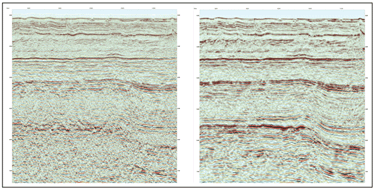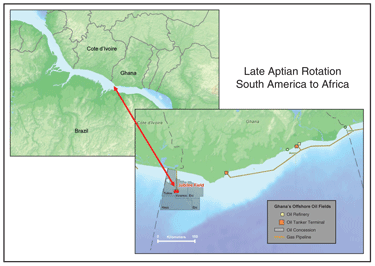
International Opportunities
Offshore ‘Frontier’ Basins In Spotlight
By Richie Miller and Gary Scaife
HOUSTON–With the extended slowdown of the Gulf of Mexico’s “independent’s playground” since April 2010, independent oil and gas companies have been looking for new areas to spend their offshore exploration budgets–especially regions in which they can apply their considerable deepwater expertise.
As companies look for high-potential international offshore acreage to explore, frontier areas such as the eastern Mediterranean, deepwater Brazil, deepwater blocks off the African coast, and Australian offshore basins are moving to the forefront. In these frontier offshore areas, new multiclient seismic data programs have been designed and acquired. Older data sets have been reprocessed with state-of-the-art processing techniques to allow the industry new access to remote areas where seismic data had been out of date, technologically inadequate, or not available at all.
The eastern Mediterranean region has emerged as a hydrocarbon exploration hot spot, in particular the deepwater area of the Levantine/Levant Basin. In 2009, the Noble Energy-Delek group drilled two deepwater natural gas discoveries in the basin: the 8.4 trillion cubic feet Tamar discovery–the largest international offshore gas discovery made that year–and the 500 billion cubic foot Dalit find. In late 2010, the group announced the massive Leviathan natural gas discovery with an estimated 16 Tcf gross natural gas mean resources, making it the largest deepwater gas discovery in the world over the past decade.
All three gas discoveries are located in subsalt Lower Miocene-Oligocene sands in large anticline structural settings in the southern part of the Levantine Basin. The Tamar well (located in Noble Energy’s Matan license) was drilled in water depths of approximately 5,500 feet and drilled to a total depth of 16,076 feet. The well encountered a reported 600 feet of net pay in three high-quality sands with excellent porosity and permeability, and high flow rates on test. After appraisal, Noble Energy is aiming for first production from Tamar by the end of 2012.
The smaller Dalit gas discovery was drilled in approximately 4,500 feet of water to a total depth of 12,000 feet. A reported gross natural gas mean resource of 500 Bcf has been estimated to be found in 110 feet of net pay in high-quality sands.
The Leviathan discovery is a huge 125 square-mile structure covering Noble Energy’s Rachel and Amit license blocks. More than 220 feet of net pay were encountered in several subsalt Lower Miocene intervals, the same as both Tamar and Dalit. Although there is little data publically available on Noble Energy’s Levant Basin wells, it was assumed that Noble’s other deeper drilling targets for the Leviathan well were the Lower Oligocene section, and more significantly, a Lower Cretaceous oil objective. Leviathan appraisal drilling is ongoing.
As mentioned previously, although all deepwater discoveries have been natural gas, there is evidence that there is also deepwater oil potential in the eastern Mediterranean region. It has been known for many years that there has been a number of Mesozoic oil seeps and asphalt indications onshore Lebanon. In the southern Mediterranean, there is an historical biogenic gas source system in the well explored post-salt Pliocene deepwater sands of the Nile Delta Cone.
As companies in these areas have drilled much deeper into the pre-Messinian salt section, thermogenic gas discoveries have been made as well as a number of thermogenic oil discoveries. Oil discovery wells around the margins of the basin are presumed to be sourced from a deeper source kitchen, possibly in the much deeper, central parts of the Levantine Basin. Oil has been found in the Cretaceous section of the Mango No. 1 well, which flowed at 10,000 bbl/d during testing from Lower Cretaceous sandstones. Oil also has been tested in the Jurassic section in two older wells offshore southern Israel, which flowed at initial rates of approximately 800 bbl/d.
High-Quality Seismic Data
High-quality multiclient 2-D seismic data sets are available for the eastern Mediterranean for initial exploration reconnaissance and to enable exploration companies to gain an excellent regional-scale geological understanding of the area.
For instance, Spectrum’s multiclient 2-D library consists of more than 22,500 kilometers of seismic data with record lengths of 12 seconds two-way time. The data set consists of four regional surveys acquired in 1975, 1993, 2000 and 2002, and all the data either have been reprocessed or are now being reprocessed using advanced prestack time migration algorithms to produce a data set that is fully compliant for amplitude-variation-with-offset (AVO) analysis. As an example, Figure 1 shows the original 2-D data at left and the reprocessed prestack time migrated data at right.
A number of additional products are also available for the eastern Mediterranean, including regional well reports, detailed petroleum geological reports, and regional prospectivity evaluation reports. In addition to the proven play seen in the deepwater wells, interpretations of this seismic data set have identified numerous play types, which range from Triassic to Tertiary plays in both shallow and deep waters.
Prior to Noble Energy’s three deepwater wells, previous regional licensing rounds had been poorly received within the hydrocarbon exploration industry. In 2007, both Cyprus and Syria underwent relatively unsuccessful licensing rounds. The Syrian licensing round was particularly disappointing with only one bid received and no blocks awarded, while the Cyprus license round only awarded one block (Cyprus Block 12) to Noble Energy in 2008.
Both Egypt and Israel are well licensed (Israel operates with an open-door policy), while Lebanon and offshore Syria have no current exploration license. Cyprus has only the one deepwater license block held by Noble and containing the Cyprus A structure, which is on trend with the Tamar and Leviathan structures.
Syria has an offshore licensing round scheduled for later this year, in which when it is rumored to be offering four offshore blocks, despite the ongoing political uncertainty and the Syrian government forces’ well publicized crackdown on protestors this spring. Cyprus is considering an offshore licensing round to be held by the end of 2011, when the government hopes to offer up to 12 blocks for oil and gas exploration. Lebanon has never had an offshore hydrocarbon licensing round, but it has announced a new energy law and new border arrangements. These measures hopefully will be the first steps in the process to allow the country’s first license round.
Assuming that deepwater drilling activity continues in earnest after the major discoveries offshore Israel in 2009 and 2010, it is hoped that awarding new licenses in 2011 and 2012 offshore Syria, Cyprus and Lebanon eventually will lead to creating the world’s next major offshore hydrocarbon producing region.
Deepwater Brazil
While the eastern Mediterranean region is generating much excitement, multiclient geophysical programs also have been defined in other frontier basins around the world that allow independent oil and gas companies access to offshore exploration acreage. One such area is deepwater Brazil, where there are plans to acquire 32,000 kilometers of high tech-driven, long-offset 2-D data. This program will commence this summer in anticipation of the next licensing round to be held by Brazil’s National Agency of Petroleum, Natural Gas and Biofuels (ANP). Offshore Brazil is one of the world’s most prospective deepwater provinces, and it has been more than three years since ANP has held an offshore bidding round, so there is considerable industry interest.
One of the new 2-D data sets being collected is in the highly sought after Northern Margins of Brazil. Very little exploration drilling has taken place within the Ceara and Barreirinhas basins of the Northern Margins, and most activity has been concentrated on the shallow waters of these areas.
Industry observers expect a direct correlation between Northern Margins geology and the geology offshore Ghana (Figure 2), which produced the 2007 Jubilee Field discovery in the Tano Basin–the largest oil find over the past decade offshore West Africa. The operator of the Jubilee Field, independent Kosmos Energy (partners are Anadarko Petroleum Corp., Tullow Oil, Ghana National Petroleum Corp., E.O. Group and Sabre Oil & Gas Holdings) reports that drill stem tests of the discovery well and the first two appraisal wells indicate that individual wells can produce at oil rates in excess of 20,000 bbl/d.
Another area in Brazil that we see has potential for discovering world-class reserves is the area “aft,” or outside of, the presalt discoveries on the Santos and Campos basins. Very little data have been collected in this area, resulting in a lack of knowledge of what takes place in this frontier region. It is known that at some point the salt and oceanic crust weld into each other and the prospectivity stops. A new survey with 12-kilometer far-offsets and long record lengths will help define what remains prospective in this area. Two other unknowns that it is hoped this survey solves are whether there are “salt islands” outbound of the limit of salt, and whether the salt in fact migrates into the northern areas of the Pelotas Basin.
Regardless, with its proven hydrocarbon potential and favorable operating environment, Brazil is an area that bodes well for the independent explorer to be able to compete for world-class opportunities.
Offshore Australia
There is a considerable amount of multiclient 2-D and 3-D data available for offshore Australia, covering hundreds of thousands of kilometers and tens of thousands of wells off the northwest coast. The data are a combination of newly acquired seismic as well as reprocessed data. Australia has consistently held licensing rounds, maintained stable regulations, and invited outside investment. This stable environment is a big plus for exploration companies entering the Australian sector, and several U.S.-based independents are already active in Australian waters.
Each time new licensing rounds are announced in northwest Australia, seismic contractors work to identify data that are available over the new blocks, reprocess the data from field tapes, and deliver it to the industry in a timely fashion to allow companies to evaluate the licensing opportunities available. Contractors also collect larger surveys to help define new frontier areas.
Other notable high-potential offshore areas where new data sets are being developed include the Italian Adriatic Sea, offshore Peru, offshore East Greenland and offshore Trinidad, to name a few. Interestingly, underexplored or frontier areas for hydrocarbon exploration are ready to be discovered.
RICHIE MILLER is president of Spectrum Geo Inc. in Houston. With 25 years of experience in the geophysical services business, he joined the company in July 2010. He served for the majority of his career at CGGVeritas and its predecessors, where he was involved with marine operations, marketing and multiclient business development. Miller holds a B.S. in geology from Steven F. Austin University.
GARY SCAIFE has 18 years of experience in the exploration, drilling and production industry, including working for the past seven years as a geologist onshore, offshore and in international assignments. Before joining Spectrum Geo Inc., he worked at Halliburton, IHS Energy, and most recently, Valhalla Oil & Gas Ltd., where he served as an exploration geologist. Scaife is a qualified-timeserved mechanical engineer and holds a B.S. in environmental geology from Sheffield University.
For other great articles about exploration, drilling, completions and production, subscribe to The American Oil & Gas Reporter and bookmark www.aogr.com.








